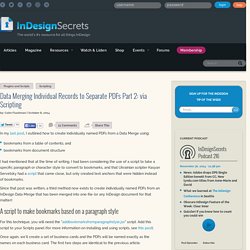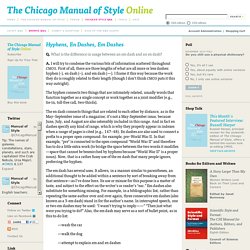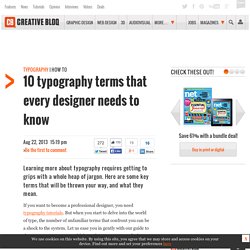

Data Merging Individual Records to Separate PDFs Part 2: via Scripting. By: Colin Flashman | October 8, 2014 In my last post, I outlined how to create individually named PDFs from a Data Merge using: bookmarks from a table of contents; andbookmarks from document structure I had mentioned that at the time of writing, I had been considering the use of a script to take a specific paragraph or character style to convert to bookmarks, and that Ukrainian scripter Kasyan Servetsky had a script that came close, but only created text anchors that were hidden instead of bookmarks.

Since that post was written, a third method now exists to create individually named PDFs from an InDesign Data Merge that has been merged into one file (or any InDesign document for that matter): A script to make bookmarks based on a paragraph style For this technique, you will need the “addbookmarksfromparagraphstyle.jsx” script. Once again, we’ll create a set of business cards and the PDFs will be named exactly as the names on each business card. 1. 2. 3. 4. 5. 6.
How to design fixed layout EPUB. Hyphens, En Dashes, Em Dashes : What is the difference in usage between an em dash and an en dash? Q.

What is the difference in usage between an em dash and an en dash? A. I will try to condense the various bits of information scattered throughout CMOS. First of all, there are three lengths of what are all more or less dashes: hyphen (-), en dash (–), and em dash (—). I frame it this way because the work they do is roughly related to their length (though I don’t think CMOS puts it this way outright). The hyphen connects two things that are intimately related, usually words that function together as a single concept or work together as a joint modifier (e.g., tie-in, toll-free call, two-thirds).
The en dash connects things that are related to each other by distance, as in the May–September issue of a magazine; it’s not a May-September issue, because June, July, and August are also ostensibly included in this range. The em dash has several uses. —wash the car —walk the dog —attempt to explain em and en dashes. 10 typography terms that every designer needs to know. If you want to become a professional designer, you need typography tutorials.

But when you start to delve into the world of type, the number of unfamiliar terms that confront you can be a shock to the system. Let us ease you in gently with our guide to the most common terms, with input from some expert designers to lead your way. Read all our typography-related posts here 01. Contrast This is a generally subjective feeling that certain different fonts work together well, giving an impression of variety without losing harmony in the overall piece. "Helvetica has low contrast and Bodoni has high contrast; two good fonts to learn about it," explains Darren Scott. To compare fonts in your browser, check out the recently launched free tool Tiff. 02.
Serifs are the semi-structural details on the ends of some strokes of letters and symbols; typefaces without these projections are known as sans serif. 03. Tracking is the amount of space between letters in a complete word or sentence. 04. 05. 8 InDesign Pro Tips. Adobe InDesign Tips I Wish I'd Known When Starting Out. Advertisement I love Adobe InDesign.

For multi-page documents, it’s the most flexible and complete application out there. Yet I remember how counter-intuitive some things were when I was learning it for the first time. Here are some tips I wish I had known when starting out, as well as some answers to questions that others often ask me. This is not intended to be a manual; some good ones are already out there (although I personally learned by doing). Margins And Bleeds If you are preparing a document for print, keep your margins and bleeds in mind from the beginning.
Master Pages When you have a multiple-page document, such as a brochure or catalog, using master pages will save you time. To set them up, bring up the Pages palette and double-click on “A-Master.” Add all of the elements that are repeated throughout most of your document: guides, page numbers, a running text box, image frames, graphic elements, etc. Frames InDesign places your content in frames. Resizing Content in a Frame (al) Issues : InDesignSecrets. Learn InDesign CC. Adobe InDesign CS6 review.